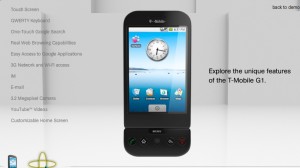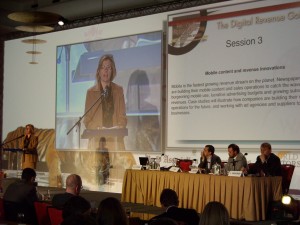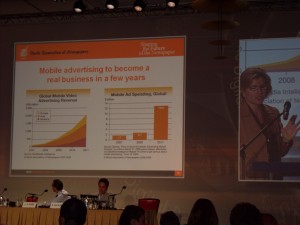Facebook has added mobile facility to comment on status updates and saw nearly a million status comments in the first 24 hours. What does that mean for mobile and social media, asks the Blog Herald?
Category Archives: Mobile
So was it the ‘Blogs Wot Won It’ for Barack?
So it doesn’t need saying that US Election 2008 took place in a very different media climate from the one experienced in 2004: just take a look at CNN à la 2004, and CNN right now.
It’s hard to actually think back and remember that four years ago the focus for many of this year’s online followers was still on the TV screen.
Last night we followed live-streams. We Twittered. We traced maps. We enjoyed striking homepage designs as the results came in.
This was the year for multimedia to really come into its own. The public outside the electoral college had a chance to participate from afar. Many bloggers might not have had a vote, but they could be influential: by spreading round a Sarah Palin debate flow-chart, casting a vote on a remote voting map, or putting a supporting button onto their sites (the online version of the rosette).
MercuryNews.com gave these, as the ninth and tenth reasons for McCain’s defeat:
9. “The Internet. Obama broke an earlier pledge and opted out of public financing, allowing him to raise at least $200 million in September and October, in millions of donations averaging $86. He raised more than twice as much money as McCain, and was able to pay for staff and ads in states and in numbers that McCain could only dream about. His 30-minute infomercial six days before the election drew more than 34 million viewers — more people than watched the finale of ‘American Idol’ last year or the final game of the World Series.”
10. “Better ground game. Obama mobilized young people and used technology, from text messages to internet meet-ups, in ways that built the first truly 21st century campaign. It might have brought guffaws at the GOP Convention, but it turns out that being a ‘community organizer’ is a good skill to have when running a presidential campaign.”
Obama’s campaign page thanks the various efforts of his internet supporters, links to his mobile content, and shows where you can find ‘Obama everywhere’:
And what about the negative effect for McCain? You may have your reservations about this story, but Fox News reported in July how McCain supporters could have been hijacked through spam reports to Google Blogger, prompting a Republican blogger move over to WordPress.
Renee Feltz, over at the Columbia Journalism Review, looks in detail at whether McCain was ‘blogged down in the past’ with ‘top-down internet tactics’, which left him unable to keep up with Obama’s social networking strategy.
This diagram shows the online blog cluster:

(screenshot, courtesy of Morningside Analytics via CJR)
Feltz describes how the map “shows a ‘halo’ of about 500 relatively new blogs in two isolated clusters. One cluster includes several hundred anti-Obama blogs (orange) and the other contains several hundred pro-McCain and pro-Palin blogs (green).”
Their isolation shows that they are not well-connected to political blogs with the longer histories, a point which John Kelly, Morningside’s chief scientist and an affiliate of the Berkman Center, explains on the CJR post.
Please do add your own Obama bloggin’ thoughts here. Was is the blogs, and which ones, which gave Obama strength? And what should we expect on the multimedia horizon for 2012?
A timely week for the Huffington Post to launch mobile
In all the election excitement, this nearly got missed but the Huffington Post went mobile this week.
Media Bistro originally reported:
“HuffPost Mobile’s election coverage includes top news stories, election results and featured blog posts. Other non-election content includes pieces from HuffPost‘s various sections like green, living, entertainment, media and style.”
It’s powered by Crisp Wireless and the two partners will now be looking to gain advertising revenue through the service, Media Bistro reports.
Google phone madness – any journos out there got one yet?
So it has arrived to the UK. The Google Phone, the T-Mobile G1.

Mixed reviews, as reported at the Telegraph. How does it compare to iPhone and will it beat it in sales?
For the journalists who reckon it’s worth it, it could prove very handy for blogging and filing away from the office. To be so darn well reliant on dodgy Wifi can be very frustrating at times. But any better than the iPhone?
Here’s a review from Times Online:’The T-Mobile G1 is great. The iPhone is better.’
Meanwhile, the tariffs for the new Blackberry Storm have been released.
Any journalists out there purchased one of these babies, and want to feedback?
Liverpool Echo relaunches print edition
As of today the Liverpool Echo hits newsstands showcasing a new style. The Trinity Mirror regional title has undergone a major face-lift after consultations with its readership.
In a statement on the paper’s website, editor Ali Machray said the local paper needed to reflect the the city’s current vibe:
“There’s a buzz about Liverpool right now. And there’s a buzz about an Echo that will bring you everything that reflects the amazing resurgence of our city and its people.”
The new look publication will feature brand new education and health sections, a section for women and comprehensive local football content. It will also sport a new design featuring a new masthead and cleaner layout.
Following last week’s launch of The Birmingham Post’s ‘Post Mobile’ service, this week sees Trinity Mirror’s Newcastle Journal and Evening Chronicle follow suit with their own news services for mobile.
Plans are still on course for Trinity to have 13 of publications active on mobile by the end of the year.
Qik could soon be live-streaming from iPhone
As reported over at Lost Remote, Qik, the video broadcasting site, are very close to launching a nifty application to allow users stream straight from their iPhones.
This video discusses how the application will also make use of GPS to further improve user interaction.
As Lost Remote says, ‘the challenge, of course, is how to organize all these streams into useful and entertaining experiences.’
WAN Amsterdam (audio): Mobile is not emerging: it’s here and we know how to monetise it, say speakers at Digital Revenue Goldmine
A range of mobile experts at the WAN World Digital Publishing Conference gave a more optimistic picture than at the AOP summit earlier this month, where speakers, including ITV’s head of mobile, said that we are still waiting for the year of mobile.
But in Amsterdam, just a few weeks later, that sentiment was turned on its head. That next year will be the year of mobile is what people have said each year for five years, said Ilicco Elia, head of mobile for Reuters. No, ‘it’s here’, he told the assembled range of newspaper experts at the World Digital Publishing Conference 2008.
Where as Elia once was employed in ’emerging media’ for Reuters, he now very much part of the mainstream product: “mobile has since emerged,” he said.
Elia certainly objected to one of Martha Stone’s slides during her presentation on online media, which said ‘mobile advertising to become a real business in a few years’. ‘My boss will shoot me, if he sees that’ he said. Elia’s been telling him that is already the case for a while; it is a real business.
While Elia stressed that he did not think “you should be going into mobile to make a lot of money immediately.” He said, “you can make more and more money slowly, slowly. Integrate into the rest of your products and it will come.”
His presentation touched on examples where Reuters have successfully monetized mobile: in the IBM ‘Stop Talking, Start Doing’ campaign (a slogan that should be applied to mobile, Elia said); by using Nokia phone cameras on for fast and effective reporting, and for widgets on iGoogle.
To think about search engine optimisation (SEO) is “a complete and utter given,” he said.
“You have to do it – SEO and SE marketing – and it is a cheap way to send people to your site,” he said.

The other mobile speakers sharing the stage, Jorma Härknönen, the senior vice president at MTV Media in Finland, responsible for internet and consumer businesses said were of similar opinion and Fredrik Oscarson, the founder and VP new business director for Mobiento, a Sweden based mobile marketing agency, were of similar opinion.
“Give it five years time, and I think people will choose to surf news on the mobile, because the mobile will have functionality [e.g GPS] that the internet doesn’t,” Fredrik Oscarson told Journalism.co.uk.
A short interview with Oscarson can be listened to here. He talks about mobile content for newspapers and different ways of advertising on mobile.
[audio:http://www.journalism.co.uk/sounds/Oscarson.MP3]WAN Amsterdam: Mobile advertising to become a real business in a few years…
Plenty more blog action to come as I file back from Digital Revenue Goldmine, WAN’s 3rd World Digital Publishing Conference. In the meantime, here’s a nice pic from Martha Stone’s (Director, Shaping the Future of the Newspaper, at WAN) talk which looked at US advertising trends. We’re currently in the monetizing mobile session – hope lots of productive hints will come out of that.

Traffic success for AP’s mobile news network
The Associated Press‘ mobile news network – launched by the agency in May – attracted 16 million page views in August, according to a report from MediaBistro.com.
The post states that 95 per cent of traffic to the network is generated by iPhone and iPod touch users.
The network, which features national news from the AP and local content from regional news organisations, now boasts 948 partners.
Local advertising on the service is sold by the news organisations, in addition to national advertising from networks, with any revenues split between news providers and ad sellers
Innovations in Journalism: Moblog – instant publishing on-the-fly
 In our Innovations in Journalism series, Journalism.co.uk asks website and technology developers to pitch their projects to us. This time it’s Moblog and its mobile toolkit for blog publishing.
In our Innovations in Journalism series, Journalism.co.uk asks website and technology developers to pitch their projects to us. This time it’s Moblog and its mobile toolkit for blog publishing.
1) Who are you and what’s it all about?
moblog:tech Ltd operates a community website, Moblog and a technology licensing firm.
Our team has been offering mobile blogging services since 2003, both to consumers wishing to blog from their phones; and to brands and businesses, who want to use mobile blogging as part of their marketing and promotional mix.
The service is a web and mobile service, so anything you post online is immediately accessible on your mobile as well.
Moblog as a platform is capable of instant publishing of content from in the field via voice (voice is converted to text and posted along with the original audio), MMS, SMS, email and via the web and mobile browser. This makes the service a perfect place to publish multimedia when it is time sensitive. This can happen direct to the picture desk behind a firewall or via RSS, it can be public and collaborative by allowing the public to post to your stream.
It is an exceedingly flexible system designed to bring web and mobile experiences together so that it no longer matters where you are publishing, reading or accessing the service.
The platform can be a complete install, such as Channel 4’s Big Art Mob (this is a build using our Participation Toolkit that we did for Channel 4); or can exist within Moblog itself as part of the network of moblogs. It can also be a standalone site in it’s own right such as the ‘Promotional Moblog’ for Dispatches.
2) Why would this be useful to a journalist?
Journalists are facing perhaps the greatest upset to the model and means of reporting that has occurred since the advent of the printed page. New audiences and new ways of reporting the news are fast becoming the norm.
Blogging is a big part of this transformation. With mobile camera phones and mobile web becoming the norm, the ability to generate images and video from mobile devices, along with audio and text, and share in a well structured manner to web and mobile sites whilst in the field is another tool now available – not only to journalists, but also to the public.
We have seen some game-changing shifts happen in how content is created, shared and disseminated, and the role of the public in adding to newsgathering and creation.
A critical example of this was the first image that emerged from within the tube tragedy on 7/7/2005, captured by Adam Stacey, which was first published on Moblog. This image became one of the seminal images associated with the event. More than this, it helped to define the emerging trend of so called ‘Citizen Journalism’.
3) Is this it, or is there more to come?
The platform is feature rich and it’s difficult to describe the possibilities (visit this link for a listing of Moblog’s features).
It’s worth mentioning that all posts can be geolocated on an integrated map on each moblog and that all moblogs are highly customisable, as reflected in the Dispatches program example above.
The platform is constantly evolving and we have a development pipeline that includes an API and other features that will be useful to individuals and clients.
4) Why are you doing this?
We started the site for fun back in 2003, with a shared passion for all things mobile, and for bridging web and mobile. We remain focused on enabling individuals, groups and clients to engage audiences on web and mobile with instantaneous, wonderful and useful content generated from their mobile phones.
5) What does it cost to use it?
It’s free to use non-commercially at Moblog, and we operate a ‘freemium model’ so that people can subscribe at Moblog for more features. Commercially, our licenses are yearly and range from £3,000 for mobile blogging solutions such as our Promotional Moblog.
6) How will you make it pay?
Our client base at this time comes predominantly from the entertainment and third sector. We intend to expand our client base for the Participation Toolkit and Promotional Moblogs. Licensing fees from these mobile blogging platforms, coupled with advertising and subscriber revenues, is how we generate revenue.